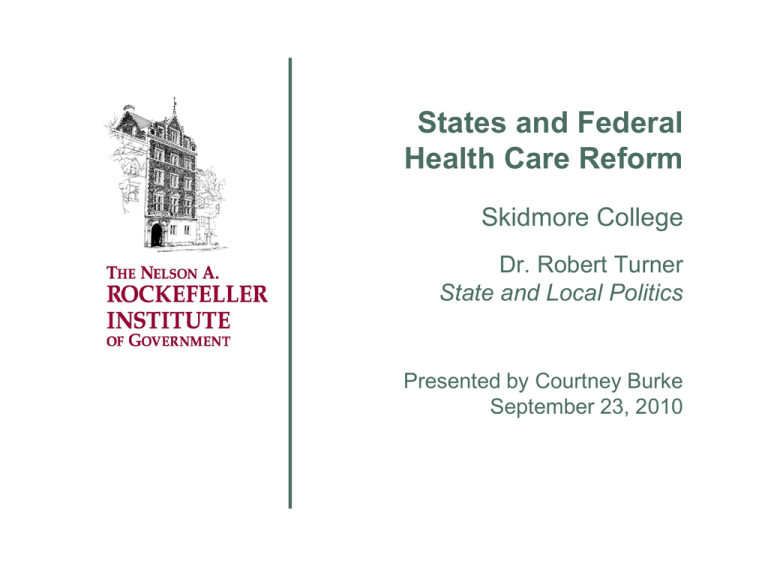States and Federal Health Care Reform
advertisement

States and Federal Health Care Reform Skidmore College Dr. Robert Turner State and Local Politics Presented by Courtney Burke September 23, 2010 Overview of States and Health Care Examples of How Governments Influence Health Policy and Law Advertising and marketing of health services & products Expending funds on public programs, including public health insurance Regulating anti-trust, health care contracting, privacy Overseeing employment, workforce, patents, taxation, disparities, consumer protection, bioterrorism, etc. Overseeing health insurance regulation, Rx regulation, human subjects research Rockefeller Institute of Government 3 Government’s Balancing Act Balance between public regulation for public health’s sake and the rights of private individuals Examples – regulating companies’ advertising of cigarettes; gun manufacturers’ liability for injury; requiring the use of seatbelts; taxing unhealthy foods What is federal vs. state jurisdiction? Rockefeller Institute of Government 4 Law and Policy Powers of Government Powers of public health agencies that directly protect and promote health Power to police (states retain this right, too) The right to tax and spend (this can coerce certain health behaviors) Provide for the public’s welfare (public health insurance) Rockefeller Institute of Government 5 Who Makes Policy? States Governors and legislatures – pass laws; allocate money; provide oversight State agencies – license and accredit; ensure public health; oversee health insurance Courts – decide on scope of law; enforcement; balance between government and individual rights; punitive role The scope and role is different in every state Rockefeller Institute of Government 6 States and Medicaid States’ Role in Medicaid Setting eligibility, benefits Overseeing payments, program integrity Enrollment and coordination Financing Overall administration Rockefeller Institute of Government 8 Interesting Things about States, the Federal Government, and Medicaid Federal government sets minimum rules, provides for at least half of total costs Medicaid (MA) is the largest grant-in-aid to states (much larger than education, transportation, or other funds) To alleviate state budget gaps, the federal government has often used Medicaid as a vehicle for helping states balance their budgets Rockefeller Institute of Government 9 Interesting Things about States and Medicaid Very different across states States have maximized flexibility Medicaid is the largest funding source for longterm care (e.g., nursing home care, home care, hospice, durable medical equipment, services for persons with disabilities, etc.) Rockefeller Institute of Government 10 Medicaid: NY and US Comparison Source: Kaiser Commission on Medicaid and the Uninsured Rockefeller Institute of Government 11 States and Medicaid Waivers Waivers are a statutory means for flexibility Waivers have allowed cuts in services, but primarily focused on expansion and innovation Research & demonstration or programmatic Rockefeller Institute of Government 12 States and Health Care Reform State Role in Health Reform: Financing Three main sources of costs for states: Increased minimum levels for Medicaid eligibility – state share “Woodwork” effect for those currently eligible but not enrolled in public insurance Administrative costs Rockefeller Institute of Government 14 Financing (Example of New York) Woodwork – Enhanced state match may not apply to those already eligible for public insurance but not currently enrolled (close to 1 million people in NY) Administrative – Enrolling thousands more people, creating new administrative entities, etc.; NY Bridge Plan, exchange Rockefeller Institute of Government 15 State Role in Health Reform: Administration Create and oversee state insurance exchanges Regulate products and rules within exchanges Regulate small group & individual markets Provide wraparound services or additional subsidies Coordinate exchange with public insurance programs Enforce individual or employer mandates Potentially administer public option or develop co-ops Rockefeller Institute of Government 16 Administration Examples in New York Exchange – upstate/downstate, statewide, interstate? Change rating rules or keep pure community rating? Who is eligible for exchange? Wrap services for those above federal eligibility levels or require them to use exchange with subsidies? Provide additional subsidies to low-income because cost of insurance is higher? Expand Family Health Plus buy-in or develop co-ops? Rockefeller Institute of Government 17 State Role in Health Reform: Implementation Update legislation, programs, and processes Request waivers from federal rules if needed Inform residents about options, provide outreach Create technology to link old and new programs Ensure services and programs mesh Create new forms and eligibility processes Assist citizens through the process Expand capacity to deal with new enrollees Rockefeller Institute of Government 18 Other Potential Roles for States What about illegal immigrants? Underinsured? Interim operator of high-risk pools in some states Creators/operators of co-op or public option What exactly might the public option be? A Medicaid or Family Health Plus buy-in? A Medicare buy-in? FEHBP buy-in? A new plan? A stop-gap? Rockefeller Institute of Government 19 State and Local Governments All states (except VT) must have balanced budgets (some annual, some semi-annual) About half of states have tax and expenditure limitations requiring supermajority or voter approval to increase taxes Supplement federal programs; fill gaps; implement programs Administer and help fund Medicaid and SCHIP Rockefeller Institute of Government 20 Example of State Role in Health Reform Implement and monitor compliance with new insurance regulations; oversee insurance products, rating rules Provide outreach and assistance to residents about new laws and regulations Set up and administer state-based insurance exchanges Provide subsidies to businesses or individuals Coordinate new programs with existing programs Help finance costs of increased enrollment Rockefeller Institute of Government 21 Class Role Play: States and Health Reform Governor Community health center State Medicaid director State Insurance commissioner Small business Medicaid enrollee Rockefeller Institute of Government 22 Class Role Play: Health Reform Explain your role in the policy process What are your priorities/interests? Where/how will you intervene in the process? What will you say to your congressperson? How will your point of view affect the process? Rockefeller Institute of Government 23 Favorite State Health Policy Resources Kaiser State Health Facts online www.statehealthfacts.kff.org National Academy for State Health Policy www.nashp.org Commonwealth Fund www.cmwf.org Robert Wood Johnson Foundation www.rwjf.org State Coverage Initiatives www.statecoverage.org Rockefeller Institute of Government 24 Rockefeller Institute The Public Policy Institute of the State University of New York Courtney Burke Director, Health Policy Research Center 411 State Street Albany, NY 12203-1003 (518) 443-5522 burkec@rockinst.org www.rockinst.org


![men_who_built_america[1]](http://s2.studylib.net/store/data/005219845_1-7979604da89ac700f7913bb56611cc41-300x300.png)






